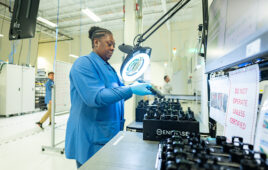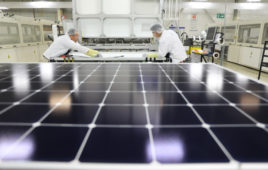GE Research, the central technology development arm for the General Electric Company, has been awarded $4.2 million in funding from the U.S. Department of Energy Solar Energy Technologies Office (SETO) to help develop and deploy advanced grid-forming PV inverter control technologies that can reliably support higher amounts of solar power on the grid. This work keeps pace with the nation’s changing electric grid system, which is getting more energy from distributed and renewable sources.
Today, wind and solar inverters connected to the grid depend upon existing voltage and frequency levels to deliver power. This is different from traditional generators, like gas and steam turbines, which dictate, or form, the voltage and frequency levels at which the grid operates.
The development of “grid-forming” controls will allow wind and solar inverters to form voltage and frequency levels like traditional generators, creating an opportunity for greater and more resilient integration of these resources into the grid.
“When it comes to solar and other renewable resources, all roads lead through the inverter,” said Maozhong Gong, Senior Engineer, Electric Power Technologies, GE Research. “As the nation’s grid sees more electricity from the sun and wind, it will require advanced inverters to maintain reliability.”
Gong added, “As part of this project, we will develop and field-test advanced grid-forming controls that enable many distributed resources to deliver reliable and resilient power like traditional generators do. We will test and validate these new technologies utilizing GE Renewable Energy’s commercial PV LV5 inverter platform. The goal is to have a solution ready to commercially deploy and implement to support the nation’s increasing solar power portfolio.”
Gong explained that while grid-forming inverter control technology is not new, the big challenge is enabling so many distributed grid-forming inverter resources to act together like traditional generators without causing stability issues. The team will address this with a holistic solution that includes advanced grid-forming controls, system modeling and analysis, and extensive tests and validation.
According to the most recent data from the U.S. Energy Information Administration, U.S. renewable electricity generation doubled from 382 million MWh in 2008 to 742 million MWh in 2018. Solar generation has increased nearly 50 times over that same period, from 2 million MWh to 96 million MWh.
This year, the EIA says solar and wind will account for 76% of all planned capacity additions. This growth is giving rise to inverter-dominated grids that will require more advanced technologies to ensure grid stability.
GE Research was selected as a part of the Solar Energy Technologies Office Fiscal Year 2019 funding program. For its project, Gong will lead a multi-disciplinary team of electric power and electrical controls experts to develop advanced control technologies for PV inverters that can support increasing solar power loads on the grid. The team will develop controls for individual and clusters of grid-forming PV inverters to improve grid stability under various conditions and field-test them in GE’s commercial PV inverter.
As part of its $4.2 million cooperative award from SETO, GE and its partners will contribute a cost share of $1.4 million, bringing the total funding for the project to $5.6 million.
News item from GE Research




“Today, wind and solar inverters connected to the grid depend upon existing voltage and frequency levels to deliver power. This is different from traditional generators, like gas and steam turbines, which dictate, or form, the voltage and frequency levels at which the grid operates.”
Wow, the VFD industry of which GE and many others have been part of for almost 50 years, pretty much has the answer. VFDs have the ability to catch a spinning motor, sometimes called “fly catcher” built into the DSP controller program. It would be this ability to monitor, sync and switch into the grid that would make this algorithm appropriate in the solar PV inverter field. Since VFDs are motor speed controllers from 0-50, 0-60 or even 0-400 HZ, the often 59.8 to 60.2 HZ requirement of the grid frequency would be a sub set of the algorithm of the VFD. VFDs come in “switching flavors”. The standard six pulse VFD, the more advanced 12 pulse VFD and the most advanced 18 pulse VFD can actually cancel out noise on the grid with the switching algorithms reacting to feed back voltages, currents and switching rates. I’ve heard this “claim” before that mechanical generation systems have the electron equivalent of “inertia” that helps regulate the grid. The reality is there will still be plenty of transformer “inertia” present on the grid with step transformers along the way from generation to end users. If it comes to that, then many VFDs today have built in line reactors or line reactors are installed for the particular load the VFD drives. ABB was in the inverter business and didn’t bother to “mine” the intellectual property of their VFD division and instead sold out their solar PV inverter business to Firmer. Why oh why does it have to be so hard?